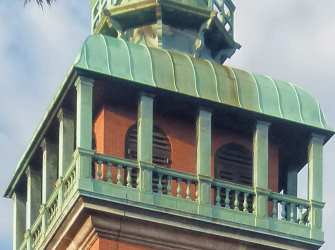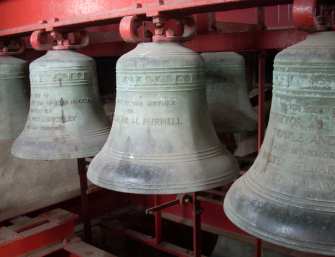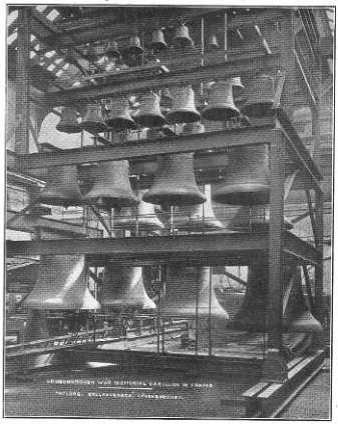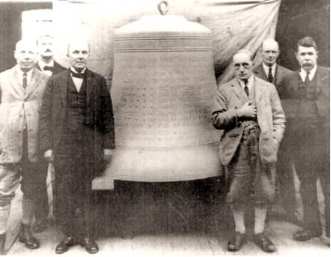The height of the Carillon tower is 151 feet (46 metres) and the top level is accessed by a spiral staircase of 138 steps. Once you've reached this level, the viewing balcony offers wonderful views over Loughborough and across the Soar Valley.

The Bell Chamber
The bell chamber is also at the top of the tower, and is, of course, an important part of the Carillon. Indeed, it is what gives the Carillon it's name. The word is thought to come originally from Old French and describes a set of bells played by a keyboard or some other mechanism.
Carillons are frequently towers, sometimes associated with churches. Like church bells, each bell plays a different note, but unlike the familiar church peels, the bells are not free to swing and are not tolled by pulling on bell-ropes. Instead they are struck by "clappers" operated by a system of leavers.
The Bells
The picture on the right shows some of the bells in the Carillon tower at Loughborough as it is today.
There are 47 bells of different sizes in the tower, each one forming a different note on the musical scale. Each bell is individually tuned to allow it to be played with the others.
The bells are played on the floor beneath and you can read more about this by visiting the Carillon Musical Instrument. and Carillon Recitals Programme pages.
The Carillon was built between 1922 and 1923 as a lasting memorial to local people who lost their lives fighting in the First World War.
The bells were produced at the local bellfoundry of John Taylor & Co, a long established firm with a world-wide reputation in the industry. The picture to the right shows the bells being assembled on frames at the bellfoundry. But their involvement was deeper than that. The Taylor family had lost loved ones themselves.
Many of the bells are inscribed in memory of fallen relatives and friends. Some are the "gifts" of local companies seeking to commemorate former employees.
Not surprisingly, perhaps, the Taylor family have also inscribed a bell, the largest bell, adding the words:
IN PROUD AND LOVING MEMORY
OF HIS THREE NEPHEWS
KILLED IN ACTION IN FRANCE
JOHN WILLIAM TAYLOR COURCELETTE 1916
GERARD BARDSLEY TAYLOR ST. QUENTIN 1918
ARNOLD BRADLEY TAYLOR CONTALMAISON 1916
SONS OF JOHN WILLIAM TAYLOR (1853 - 1919)
GRANDSONS OF JOHN WILLIAM TAYLOR (1827 - 1906)
EDMUND DENISON TAYLOR
THE FOUNDER OF THESE BELLS
GIVES THIS THE LARGEST
1923
Mr E. D. Taylor, who was head of Taylor's Loughborough foundry at the time of the Carillon's construction, can be seen standing immediately to the left of the "largest" bell in the picture to the right. The gentleman to the right of the bell is the Mayor, Mr Wilfred Moss.



